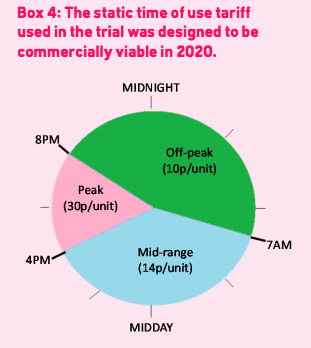Of course we would not give away total control - they would only be able to reduce it by 1 degree and even then we could have an override.
Some people have time of use tariffs now, usually the 2-level Economy 7 tariff. This is good for people with electric storage heaters because they can charge them up at night. In the future there could be lots more people who would benefit by charging electric cars at night. However, the 2 -level tariff doesn't reflect energy demand very well and a 3-level tariff would be more flexible, with a medium rate during the daytime, as shown in the chart.
 |
| 3-level tariff offered in the UCL trial [1] |
Smart meters will make it easy to select and switch between tariffs. At the moment the electricity meter man has to visit to set up Economy 7 because it involves giving you a second meter and manually setting the switching times.
To get the most benefit from a time of use tariff you need to avoid using electricity at peak times. For example you could run your tumble dryer or dishwasher later in the evening or during the afternoons. This is easier for some people than others. There have been several trials of time of use tariffs in the UK with mixed results. The Customer-led Network Revolution trial had 112 participants and they reduced peak demand by nearly 8%. However, a much larger study by Scottish and Southern Energy, including about 3000 households, was not so successful. The sample was divided into groups to test different kinds of supporting information and marketing and some of the groups actually increased peak time consumption: mainly the ones with the most information given to them [2]. This helps to confirm the theory that we really don't like having to think about our energy use.
Unfortunately, the thermostat adjustment option for reducing electricity demand at critical times only applies to people who use electricity for heating. At the moment it is still the case that most people use gas or other fuels. However, the UCL survey also included some options where appliances could be set to run automatically at cheap times. This was viewed positively by 29%, so not quite a third but still a reasonable number of us. Obviously variable rates are going to take some getting used to.
 |
| Results in the UCL survey. Static TOU had fixed times. Dynamic TOU had variable times depending on the weather. The Framing Study refers to different wording on the information sheets. [1] |
Shifting demand away from peak periods is very important for keeping our total bills down because it is peak demand that governs how much generating capacity we need. Lower peaks mean fewer power stations of all kinds, and less wires across the countryside too. So whether or not we like to think about it, we would be foolish to ignore load shifting as an option.
[1] Is it time? Consumers and time of use tariffs (UCL) March 2015
[2] Further Analysis of Data from the Household Electricity Study: Electricity Price Signals and Demand Response. (Element Energy) April 2014
No comments:
Post a Comment
Comments on this blog are moderated. Your comment will not appear until it has been reviewed.